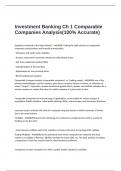Investment Banking Ch 1 Comparable
Companies Analysis(100% Accurate)
Questions answered in the video include? - ANSWER- Finding the right universe of comparable
companies using business and financial characteristics
- Enterprise and equity value multiples
- Treasury stock and if-converted methods for fully diluted shares
- Net share settlement method (NSS)
- Calendarization of financial data
- Adjustments for non-recurring items
- Benchmarking and valuation
Comparable Company Analysis (comparable companies" or "trading comps) - ANSWERIs one of the
primary methodologies used for valuing a given focus company, division, business, or collection of
assets ("target"). It provides a market benchmark against which a banker can establish valuation for a
private company or analyze the value of a public company at a given point in time.
Comparable companies has a broad range of applications, most notably for various mergers &
acquisitions (M&A) situations, initial public offerings (IPOs), restructurings, and investment decisions.
a process used to evaluate the value of a company using the metrics of other businesses of similar
size in the same industry
Multiples - ANSWERMeasures the well-being of a company by comparing two metrics, usually by
dividing one by the other
- most common multiple used in the valuation of stocks is the price-to-earnings (P/E) multiple.
Trading Multiples - ANSWERused to understand how similar companies are valued by the stock
market as a multiple of Revenue, EBITDA, Earnings Per Share, EBIT, etc. The basic premise of making
a comparison is that they assume that the stock markets are efficient.
Comparison to other companies for which a public market valuation is available
,utilize a measure of value in the numerator and a financial statistic in the denominator.
Trading Multiples Examples - ANSWERenterprise value-to-earnings before interest, taxes,
depreciation, and amortization (EV/EBITDA), Price-To-Earnings ratio (P/E), EV/Revenue, Enterprise
value before Interest and Taxes (EV/EBIT).
Why do bankers use Enterprise Value (E/V) instead of Price to Earnings (P/E) - ANSWERBecause they
are independent of capital structure and other factors unrelated to business operation (e.g. ,
differences in tax regimes and certain accounting policies).
What is Comparable Company Analysis designed to do? - ANSWERDesigned to reflect "current"
valuation based on prevailing market conditions and sentiment. As such, in many cases it is more
relevant than intrinsic valuation analysis, such as discounted cash flow analysis
Comparable Companies Analysis Steps - ANSWER1) Select universe of comparable companies
2) Locate the necessary financial information
3) Spread key statistics, ratios, and trading multiples
4) Benchmark the comparable companies
5) Determine valuation
Step 1 Select the Universe of Comparable Companies - ANSWER- The selection of a universe of
comparable companies for the target is the foundation for performing trading comps
- As a starting point, the banker typically consults with peers or senior colleagues to see if a relevant
set of comparable companies already exists internally
- Companies in the same sector (or, preferably, "sub-sector") with similar size tend to serve as good
comparables
Step II. Locate the Necessary Financial Information. - ANSWERLocate the financial information
necessary to analyze the selected comparable companies and calculate ("spread") key financial
statistics, ratios, and trading multiples
Step III. Spread key statistics, ratios, and trading multiples - ANSWER- involves calculating market
valuation measures such as enterprise value and equity value, as well as key income statement
items, such as EBITDA and net income
- variety of ratios and other metrics measuring profitability, growth, returns, and credit strength are
also calculated at this stage. Selected financial statistics are then used to calculate trading multiples
for the comparables
Step IV. Benchmark the Comparable Companies - ANSWER- Lay out the calculated financial statistics
and ratios for the comparable companies (as calculated in Step III) alongside those of the target in
spreadsheet form for easy comparison. This is known as Benchmarking
, Benchmarking - ANSWERa process by which a company compares its performance with that of high-
performing organizations
- Serves to determine the relative strength of the comparable companies versus one another and the
target. The similarities and discrepancies in size, growth rates, margins, and leverage, for example,
among the comparables and the target are closely examined.
- This analysis provides the basis for establishing the target's relative ranking as well as determining
those companies most appropriate for framing its valuation.
- The trading multiples are also laid out in a spreadsheet form for benchmarking purposes
Step V. Determine Valuation - ANSWERTrading multiples of the comparable companies serve as the
basis for deriving a valuation range for the target
- banker typically begins by using the means and medians for the relevant trading multiples (e.g.,
EV/EBITDA) as the basis for extrapolating an initial range.
- The high and low multiples for the comparables universe provide further guidance in terms of a
potential ceiling or floor.
Ex: Within the industrials sector, for example, there are numerous sub-sectors, such as aerospace
and defense, automotive, building products, metals and mining, and paper and packaging. For
companies with distinct business divisions, the segmenting of comparable companies by sub-sector
may be critical for valuation.
What does a companies Sector tell you about it? - ANSWERA company's sector conveys a great deal
about its key drivers, risks, and opportunities. For example, a cyclical sector such as oil & gas will
have dramatically different earnings volatility than consumer staples. On the other hand, cyclical or
highly fragmented sectors may present growth opportunities that are unavailable to companies in
more stable or consolidated sectors.
Products and Services (Business Profile) - ANSWER- Company's products and services are at the core
of its business model.
- Accordingly, companies that produce similar products or provide similar services typically serve as
good comparables. Products are commodities or value-added goods that a company creates,
produces, or refines.
Examples of Products: include computers, lumber, oil, prescription drugs, and steel. Services are acts
or functions performed by one entity for the benefit of another.




